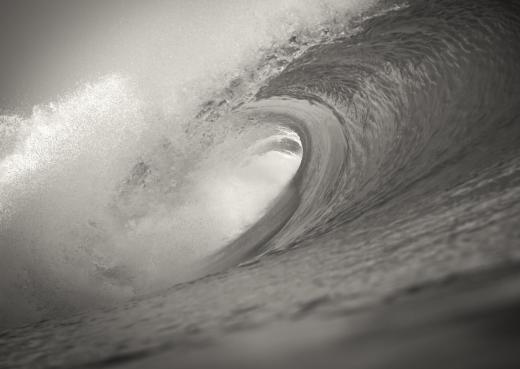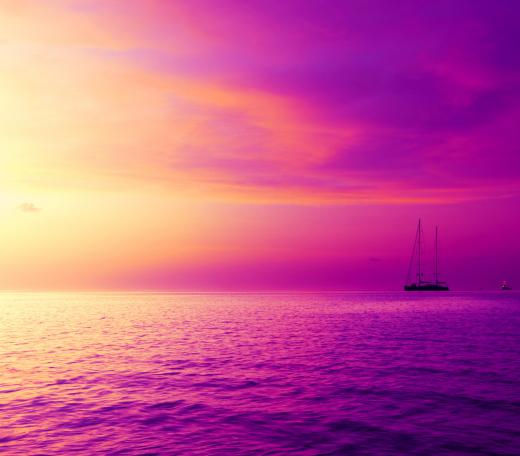What are Tidal Waves?
 Mary McMahon
Mary McMahon
The term “tidal wave” is used in several different ways inside and outside the oceanographic community. Technically, tidal waves are the crests of the tides which move across the surface of the Earth, and this is the usage of the term which is preferred by oceanographers and other people who study water and the movement of the ocean. However, many laypeople refer to other types of waves, such as storm surge and tsunamis, as tidal waves.
In the case of the tidal crest, tidal waves are constantly moving across the surface of the Earth as the Earth's water rises and falls, creating the tides. The size of a tidal crest can vary, depending on the relationship between the Earth and the moon and the area. The term “tidal wave” is also used to discuss tidal bore, a phenomenon which occurs in areas with large extremes between low and high tides. In these regions, when tides enter a narrow inlet, a large wave develops as the tide floods in. The tidal bore can flow up rivers and streams as it floods into land, often moving against a strong current.

For laypeople, “tidal waves” are extremely large waves caused by unusual weather conditions. Storm surge involves radical increases in the height of the ocean, along with very rough waves, caused by stormy and intense conditions. Many hurricanes are accompanied with storm surge which can overcome levies and other barriers which are designed to keep the water back, and this flood of water can cause significant damage, especially in low-lying communities.

Tsunamis are created when large amounts of water are displaced. Classically, a tsunami occurs when an earthquake shifts the water, creating a powerful wave or set of waves. Tsunamis are especially common in the Pacific Ocean, around the famous “ring of fire” which is noted for its high levels of geologic activity. Tsunamis can also be caused by volcanic eruptions when these eruptions appear close to the water.

Some people also refer to rogue or freak waves as tidal waves. These waves typically occur out in the open ocean, and the reasons for their development are a bit unclear. However these waves form, they can become extremely large. Some researchers suspect that the mysterious disappearances of ships could be explained by rogue waves which overwhelmed the craft while they were underway.
Tsunamis, rogue waves, and storm surge have nothing to do with the tides, making “tidal wave” an inappropriate term to use to refer to them. However, the widespread misusage of this term is unlikely to fade, and many oceanographers have given up on trying to educate people about which terms to use, especially since the media is especially fond of describing any unusual wave as a tidal wave, whether or not the tides are involved.
AS FEATURED ON:
AS FEATURED ON:













Discussion Comments
@ IStria & PelesTears- If you want a really good example of a tidal bore that creates a super tidal wave, you should look at videos of people surfing the bi-annual wave at rapid # 11 on the Zambezi River. Twice a year the water level of the Zambezi rises and falls, creating an endless, perfect tube. The current is strong, and you will need a vest, but any experienced surfer who normally rides reef breaks can handle the wave. You can actually take tours to kayak and surf the wave when this phenomenon occurs. you will not have more than a month to prepare though because the wave shows up at different times, and is only predictable a month out.
@ istria- Technically the waves you witnessed were storm surges and not tidal waves. If you want to see an example of a famous tidal wave and tidal bore, look up videos of the Quiantang River tidal bore in your search bar. It is quite impressive, and it happens every year. Tidal waves and tidal bores are somewhat predictable. They happen during the change in tides during extreme tides.
I used to live on the Big Island, and I was there during the time of Hurricane Iniki that devastated Kauai. The storm was forecast to make landfall along the coastline of the big island near our house. Waiting for the hurricane was the worst moment of anticipation in my life; hearing the sirens going off for hours, getting wind gusts that could lift you off your feet, and being on an island that was completely silent. Luckily for us, the storm turned not far from shore, and turned towards Kauai.
Anyway, the storm created a number of large tidal waves that pounded the coastline for days. I remember going to the beach with friends and watching some of the more experienced surfers riding monster waves. None of us were foolish or brave enough to get in the water, but it was impressive to watch the massive swells roll in. I am not sure if these are technically massive tidal waves or huge storm surges, but the surf was big, easily topping 20 feet.
Post your comments